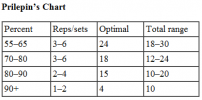When in doubt I autoregulate using a system based on prilepin chart.
After solid warmup:
Set 1 - weighted - main work set (near tech failure)
Set 2 - 2 fewer reps than work set
Set 3 - 4 fewer
Set 4 - drop weight - 2 more reps than weighted work set
X, -2, -4, +2
Example:
Ramp up with sets of 5 until you're close to working weight (rep max will be 5-10ish)
Vest x 5,3,1 bodyweight x 7
When you're stronger or on an easier weight or exercise it could be 10,8,6,12 & still work...
Just did this w/ Presses. Ramped to work set of 6 (~85%). Followed with 4 & 2. Dropped weight 10% & did 8.
12 total reps @ 85%, 20 total volume.
Author used this for group training so weights wouldnt need to be changed constantly. Just set bars @ 225, 255, 275, whatever gets you in the range.


